HAY … WHILE THE SUN SHINES
When travelling up the Wye River valley, which meanders gracefully betwixt Wales and England, there can be no more glorious portal than the great ruined Abbey at Tintern. We came upon it not from the river course, but along the winding Welsh road from Chepstow. One moment we were in the trees and suddenly, a grassy meadow and the majestic ruin, towering over the road and the surrounds, a veritable stone skeleton of immense strength and beauty. How it must have captivated and marvelled people when the present stone structure was built in the thirteenth century as a place of worship by Cistercian monks. How, they must have wondered, could anything so tall and solid be built so far into the sky? Its ruination began during the reign of Henry VIII with the primacy of state control over church, but in the eighteenth and nineteenth centuries, poets like Wordsworth and Tennyson and the painter Turner helped popularise Tintern Abbey as the most beautiful and romantic ruin in Britain. In the soft light of the behind-the-hills sun, we saw it after the tourist deluge had left. The grass inside the great nave and transepts looked like billiard table baize, and the stone was tinged yellow. The enormity of the ruins reminded me of a patriarch, long in years and now lost for physical powers, but still commanding and compelling, through sheer physical presence alone. But for the grumble from the road, all was quiet, almost as though in a place of such reverence, it was impertinent to talk above a whisper.
We passed through grey-stoned Monmouth, long the seat of power of the same named Dukes, and on a signboard at the grey Monmouth school it said "Boarding school for Ages 7 to 18". For a moment I thought of those wee little seven year olds, crying for their mums, alone and deserted while outside the cold rain fell on a cold grey morning. I remembered my father's gravest threat, "If you don't behave, we will send you to boarding school". It worked with me, because I had seen pictures of places like Monmouth, and it gave me a life-long loathing of such institutions for the very young!
On this warm, soft, mauve evening, the Wye River looked like molten platinum and the river meadows lush and inviting. We flashed by the sign to Symonds Yat West, but I braked in time for the sign to Symonds Yat East, and I saw my wife look up at the car's sun-visor with that “Hell, what now” look. We had, I know, been driving long, and our target of Ross On Wye was only six miles hence. "Just a quick look" I advanced, but there was no reply. It was not a good sign. We travelled across a small, single lane stone bridge, and through pasture land, with the river always ahead of us as though on a lead. Then, at a lolling bend where the Wye is less than a hundred metres wide, there were some dinky little houses and lodges. And at the end of the road, above a gravel car park, stood The Royal Lodge looking mock-Tudor, probably Victorian, and on closer inspection, smelling Edwardian. And "yes", they had a room. My wife looked askance, but I kept my eyes low and said, "Up to you, dear" although her choice would provide me with little defence later, if the place was a disaster. It would then be 'It’s all your fault', but in that way, we husbands are all Hobsons. I handed over my credit card, and went to get the bags.
There were many stairs in The Royal Lodge, which I discovered had been built as a riverside holiday lodging in 1881. 'On the river and near the train' said the sepia advertising poster. The carpets were gawdy in that “oh-my-Gawd” way, and the corridor walls were littered with shots (and I use the word carefully) of magnificent stags, who had long ago been consigned to the pot. There were wall prints of Tintern Abbey, and of steam trains in mountain cuttings, and along the corridors there were lots of pipes and those ancient hot water heaters to keep the cold at bay. Our room was basic but adequate, with only the small television and the shower rosette not being from the last century, while the furniture was heavy, with rosewood and walnut. Indeed, the bed lamps were, I am sure, early Edison proto-types! That said, we slept well, the food in the restaurant was good, and the Dorothy Goodbody ale that I drank, was the best that I tasted in England!
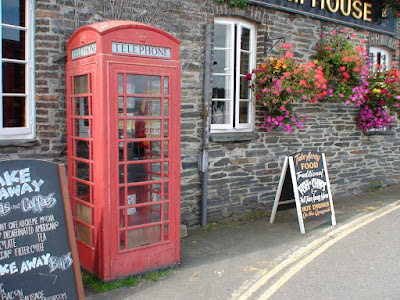
British Fish & Chips
In the morning I walked along the plate-glass river, past garden beds full of still sleeping gladioli, nasturtiums, and daisies, the hills all russet with the coming of autumn, and it all looked like the dawn of creation. Small boats, festooned with flower boxes, were frozen to their mirror images, broken here and there by a shimmying zephyr. The huge Yat Rock above the tight valley, was the first to catch the sun, and it looked like molten gold. Then, the light changed, and with it the clouds came, and too a breeze which carried the voices of deliverymen, chefs and other early-get-uperers. The river mirror fogged over like a bathroom mirror when one is shaving and another showering, and while many in the Royal Lodge still slept under their fine, warm, non-poetic blankets, my personal morning stanza was over. The working day had begun.

The River Wye, at Symonds Yat, in the early morn, looking towards West Yat
Later that morning, we drove the six miles to Ross on Wye, following the river course and passing on the way, the expansive ruins of Goodrich Castle which had been mortared into submission by the giant “Roaring Meg” during the English Civil War. Ross is a pleasant hilltop market town, with lots of black and white buildings which are so prevalent in the counties of Herefordshire and Cheshire. It has a wonderful red-stone Market House dating from 1650, buildings which once housed the Corn exchange and the Butter exchange, and a 700 year old parish church, which can be seen from miles around. The town was full of small shops and wonderful looking old hotels, and I hoped my wife would not make a comparison with the Royal Lodge, as we had planned to stay in Ross. The town is sited above a particularly attractive bend in the river, and I learned that the English tourist industry had probably begun there in 1745 with the publication of a book called “Boat trips on the River Wye”. The book was so popular that the boat owner was swamped with visitors, and forced to mightily expanded his fleet. The area has been a haven for tourists ever since, especially as it also includes part of the wild Forest of Dean, which was once a Tudor hunting preserve and a pristine forest. Indeed, timbers from the forest were used in the making of HMS Victory.
From Ross we headed for Hereford, and again the rain came with vigour. Hereford is a sprawling county capital, one of the oldest cities in Britain, and was in 700 AD, the Saxon capital. It once had a castle as elegant as Windsor, but after the Welsh stopped coming to attack, it was dismantled in the 1700’s. Hereford, therefore, is full of the most wonderful architecture, with its ‘gold tooth’ undoubtedly being its Cathedral which was built in 1079. The Cathedral grounds, also house a Bishop’s Palace and it is the oldest, continually occupied, bishopric in the country. Outside, there is a wonderfully evocative bronze sculpture of Sir Edward Elgar, who lived outside Hereford from 1904 to 1911, striped of all pomp and circumstance, leaning against his bicycle and gazing wistfully at the Cathedral. We can only be left to ponder what musical notes were running through his head and just maybe, he was already humming Land of Hope and Glory as he looked on!
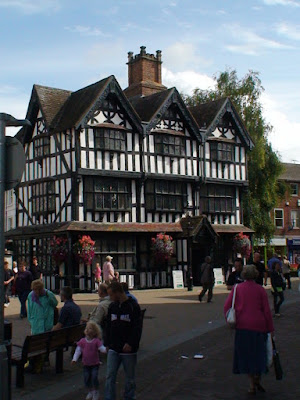
Hereford Beauty
Hereford is full of signature black and white buildings, sturdy and aged hotels, and sported a wonderful building once the Corn exchange and a huge Butter exchange which is now an indoor market. In the Uptown area, there were plenty of cheap shops and all-you-can-eat places, plus lots of young mums with babies in strollers. There were too, plenty of youths lolling around in the parks, and peroxide blonds with coal-black eyes, all wearing the briefest shorts, which showed the benefits of Brazilian waxing. Unfortunately, youth unemployment is particularly high in Hereford. In a backstreet, I came across the headquarters of the Hereford Cattle Association and a shingle showing the familiar head of the beast, which is now raised all over the world. When later we drove past the cattle auctions, it was easy to see that Herefords were well in attendance, both in terms of men, and beasts.
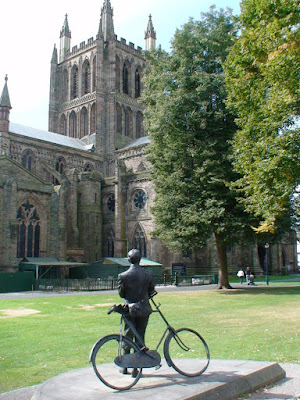
Hereford and Elgar
The road from Hereford in England to Hay on Wye in Wales, is a pretty one, through beautiful farmland country, with petite villages and tree enshrouded manor houses, and always the mountains riding shotgun. The rain and low clouds sat on our rooftop, but just as Hay loomed, and we crossed the River Wye yet again, the sun shone on us, and Hay, in all its glory. Like taking a tome from the library shelf, we entered the world famous Town of Books with much anticipated pleasure. In 1961, Richard Booth opened a second-hand and antiquarian bookstore in Hay on Wye, and now, wherever you take a Captain Cook, why there's a book! The town visitor blurb will tell you that there are now 30 bookstores, and over a million books “for sale” in little Hay on Wye. The town itself is a maze of streets and alleys, and everywhere you go, there are bookshelves full of books. Even the stores have that wonderfully musty smell that you associate with dingy libraries, cellars, and grannies.
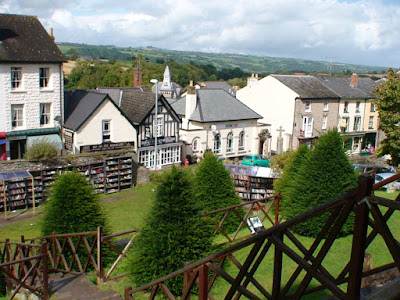
Hay on Wye Castle View with Books
We made our way first to the town's highest point, an early twelfth century castle which was variously attacked by the English and the Welsh, till it was destroyed by King John in 1216, probably still annoyed at having signed the Magna Carta a year earlier! The view of the countryside is spectacular, but what caught my eye even more was the foreground where rough pine shelving contained thousands of books, open to the winds and sun, but sheltered from the rain by plastic awnings. It was 50 pence for a paper-back, a Pound for a hard cover, and nearby was an Honesty Box. All about, there were people searching shelves, or just sitting on fruit boxes and having a read in that toe-in-the-water manner. I found what I thought was a biography on Ivana Trump, and bought it for my wife, who is an avid reader of biographies. My Pound coin kerplunked into the Honesty box with the deadening sound that told me there were already a few coins gathered, and had our suitcase not been ready to bust, I would have bought many more. There was little order to the stacks, indeed a Pamela Anderson book breasted a work by the Archbishop of Canterbury, a strange cleavage of juxtaposition, I suppose, and I felt as though you needed days to survey the stacks, not just a few hours.
In the streets, the bookshops were quainter and I was sure you would find an original Gutenberg bible or a first edition Dickens, if I looked for long enough. I am sure too, that on one of the old maps, I saw Vasco de Gama's signature! Up and down the streets were men pushing barrows, for many alleys were too small for delivery vans to navigate, and the shops had almost a doll-house quality to them.. There were fudge parlours and an ice-cream parlour with lead glass windows and old fashioned cones, B&B's every bit available for chocolate box covers, and a clock tower which was a bit like a Mini-me Big Ben. We found the Blue Boar pub just as the rain started again, and had a Welsh Rarebit Bap and a pint, then hurried to the car and pointed the Polo at the peaks of the Brecon Beacons. Hay, while the sun shines is fine, but the rain was a curse for chapter and verse, so we put down our book, and went elsewhere to look. What was it that Wordsworth said about a poet not being gay – in the old fashioned way that word is used, if you please!
The bald and brooding Breacon Beacons kept us company as we drove, with fighter aircraft making frequent sorties over our car, for here the military train before going to Afghanistan. We passed through the handsome market town of Breacon and went up over the Beacons and down the beautiful valley to the town of Abeverenny. Our heads turned constantly at the stunning scenery, for no-one does valleys like the Welsh, and even though we were heading down, I sang, in my mind, that delightfully rollicking song by Marty Wilde, Taking a trip up to Abergavenny. Ah, sunshine forever, lovely weather – don't you wish you were me! (Well I don't expect you would want to be 'me', if you were Rudolf Hess, the Deputy Fuehrer who flew to Britain in 1942, was captured, and spent the rest of the war imprisoned near Abergavenny, and the rest of his years imprisoned in Berlin!) And then, before you could say "the ruins of Raglan Castle" we were back in England again. Wales had had so much to Offa, but our time was up. It was time to head home.
In cyclonic rain, we inched through the Forest of Dean and somehow found the way to Gloucester. Then we found a fast road, and our little Polo rejoiced at getting into fifth gear at last, particularly as the sun came out, just as we hoped it would. We stopped for coffee in the beautiful town square of Cirencester, the "Capital of the Cotswolds", and then in the voice of GPS Jane, proceeded to "Take the motorway" and we headed for Streatley on the River Thames for lunch. There we had a choice, “The Bull” where Jerome K Jerome wrote Three Men in a Boat and in the garden is a fifteenth century grave of a monk and a nun who were both executed for ‘misconduct’, or “The Swan”, once owned by Danny La Rue. Even though it was a little further away and therefore a bit of a drag, the sun was shining, and the Thames looked so pretty, so we went for “The Swan”. We were not disappointed, for the swans came with geese, ducks and water-hens in tow, and helped us with our Club sandwiches. There can be few sights more lovely than to sit in the sunshine by the tranquil Thames, looking across to the lock at Goring, and watching the boats, and all that floats on the river. We would have loved to stay for the afternoon, but we had an appointment in Windsor.
Now Windsor is a lively town, even when the Windsors are not in residence, a place of tourists and locals, pubs and coffee shops, places made for eatin’, and Eton. The area around the Castle is always packed with tourists, all milling and shouting under the unimpressed eye of a dour looking Queen Victoria. But pop into Market Street, and you waft back through the centuries. Here lived the veritable pompadour of mistresses, Nell Gwynne, a mere ‘just whistle’ from the castle, and above the door of an ancient pub, is Cromwell’s signed order for the execution of King Charles I. Around the corner is the ancient Guildhall, refurbished in 1951 by the Princess Elizabeth, and again in 1986 by Prince Phil, and a marvellously medieval leaning house which looks as though you can blow it over. Around the railway station, with arches dating from 1897, is now a huge, attractive, under-cover pedestrian walk space full of eateries and coffee shops, and a replica Royal steam train, “The Queen” which in 1894 brought Queen Victoria to Windsor. Down along the Thames, I wandered past the house of the great architect, Sir Christopher Wren, now an upscale hotel, and watched a hundred or so swans floating serenely, quite as one might expect in Windsor. Then through small streets I went, to Eton College, and the playing fields of England, passing a number of establishments which young Etonians might have slipped into, over the centuries, for an under-age drink.
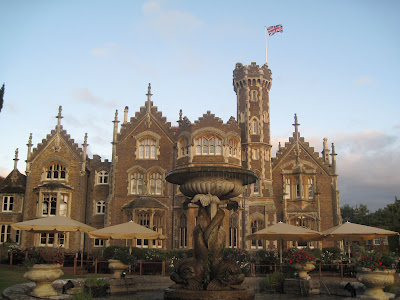
Oakley Court Fountain
We were lodged at Oakley Court, a few miles along the Thames from Windsor, at a stately mansion house, constructed in the 1850’s, and looking like something out of Disney’s magic kingdom. It was once with its own woods, now a golf course, and Ma’am herself had been there only a few weeks earlier, alighting from a Royal barge, capes no doubt, thrown in her path along the riverbank. The Oakley foyer was decidedly hallowed, and the sitting rooms and drawing rooms full of Chesterfields, and walnut panelling, all rather baronial. I heard the receptionist say that most tuneful of phrases, “An upgrade to a suite”, and we had our own huge suite with all comfort of appointments, a great four poster bed, and all with Thames view. Ahh, Dieu et mon droit, a royal might have said. We just thanked ‘Him’! Later we learned that Charles de Gaulle had stayed at Oakley Court during WWII, but more enticingly, all the St Trinian’s films had been shot there, and at night it was hard for me to find sleep, thinking of all the frilly knicker crowd that must once have assembled in this very room! Dinner was quite beautifully served by black-tied men, and by women with little stiff cotton coronets in their hair, and as might be expected, the Brown Windsor soup was beyond delicious. Coffee and port were mandatory in the wood panelled bar, or the book-lined library, and all that was missing, was the smell of cigar smoke and old men.
We were sorry to leave the next morning, especially as the wind was shrieking and the rain lashed the window panes. Twelve hours later, we were melting in Bahrain, and the sun hadn’t even risen. It was hard not to think that it hadn’t all been a fairy tale!
Winfred Peppinck is the Tales of the Travelling Editor for Wandering Educators
All photos courtesy and copyright Winfred Peppinck.
